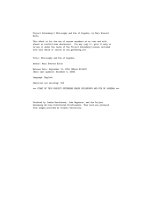Project Gutenberg''''s Paper and Printing Recipes, by J. Sawtelle Ford docx
Bạn đang xem bản rút gọn của tài liệu. Xem và tải ngay bản đầy đủ của tài liệu tại đây (536.17 KB, 228 trang )
Project Gutenberg's Paper and Printing
Recipes, by J. Sawtelle Ford
This eBook is for the use of anyone
anywhere at no cost and with
almost no restrictions whatsoever. You may
copy it, give it away or
re-use it under the terms of the Project
Gutenberg License included
with this eBook or online at
www.gutenberg.org
Title: Paper and Printing Recipes
A Handy Volume of Practical Recipes,
Concerning the
Every-Day Business of Stationers,
Printers, Binders, and
the Kindred Trades
Author: J. Sawtelle Ford
Release Date: May 17, 2010 [EBook #32400]
Language: English
*** START OF THIS PROJECT GUTENBERG EBOOK
PAPER AND PRINTING RECIPES ***
Produced by The Online Distributed
Proofreading Team at
(This file was
produced from images
generously made available by The Internet
Archive/American
Libraries.)
Paper and Printing
RECIPES
A Handy Volume of Practical Reci-
pes, Concerning the Every-Day
Business of Stationers, Print-
ers, Binders, and the
Kindred Trades.
PUBLISHED BY
J. SAWTELLE FORD,
OFFICE OF “THE STATIONER AND
PRINTER,”
CHICAGO.
Entered according to the Act of Congress,
in
the year 1883, by
J. SAWTELLE FORD,
In the Office of the Librarian at
Washington.
GLIMPSE OF
CONTENTS.
This Volume has nearly
Two Hundred valuable
Recipes for Stationers,
Printers, Bookbinders,
etc. These Recipes are
thoroughly practical, and
such as come up in every
day’s work. They have
been gathered from many
sources, and are
endorsed by the best
workmen of the United
States and Europe.
INDEX TO RECIPES.
WRITING INKS.
Removing Writing Ink from Paper 1
White Ink 3
Purple Hektograph Ink 3
A Dark Red Indelible Ink 4
Making Carmine 4
Violet Ink 5
Indelible Ink 5
To make Black Ink 6
An Ink which cannot be Erased 6
Copying Ink to be used without Press
or Water
3
A Cardinal Ink 7
A Portable Ink 28
Indelible India Ink 28
Copying Inks 29
Invisible Writing 68
PRINTING INKS.
To Prevent Colored Inks from
becoming Hard
81
To keep Colored Inks from Skinning 81
To Preserve Colored Inks 82
How to Brighten Common Qualities
of Colored Inks
83
A Good Dryer 79
A Quick Dryer 61
Improved Dryer for Printing Ink 66
To take Printer’s Ink out of Silk 17
Red Printing Ink 68
Black Printing Ink 69
Colors for Printing Ink 71
Principal Colors of Gold for
Grinding
45
MARKING INKS, ETC.
Ink for Rubber Stamps 7
Marking Ink 10
Black Ink for Stencils 6
Stencil Ink 2
Blue Marking Ink for White Goods 10
REMOVAL OF INK STAINS, ETC.
To Remove Writing Ink from Paper 1
To Remove Aniline Ink from the
Hands 8
To take Ink Stains from the Hands 9
To Remove Grease Spots from Paper 13
How to Remove Colored Inks 81
Paper for taking out Ink Stains 14
To Remove Ruling Ink Stains from
Fingers
17
To Remove Ink Spots 19
To Remove Oil Marks from Paper 20
To Remove Ink Stains from
Mahogany
20
CARE OF BOOKS.
Care of Books 78
To Destroy Book Worms 77
How to Prevent Mildew on Books 78
GLUES, PASTES, MUCILAGE, ETC.
Solid Pocket Glue 20
To Test Glue 21
Book-Binder’s Glue 22
Cement for Glass 22
Postage Stamp Mucilage 26
To keep Mucilage Fresh 26
Mucilage 27
Mucilage for Pasteboard 27
Cement for Labels 23
A Colorless Cement 23
A Cement that will Resist the Damp 24
To make Glue Water-proof 24
Two Glue Receipts 25
A Good Paster 29
A Paste which will not Spoil 29
A Silver Solder 30
An Article for Labeling Bottles 8
For Making Dextrine 70
PRINTERS’ VARNISHES.
A Varnish for Color Prints 82
Printers’ Varnish 83
A Varnish for Paper 13
A Transparent Paper Varnish 53
COLOR AND GOLD LEAF
PRINTING.
To Fix Bronze Colors on Glass 77
A Bronze or Changeable Hue 80
Gold Leaf Printing 80
Inking Surfaces for Color Work 82
Colors for Holding Bronze 2
Colors for Printing 51
ELECTROTYPING.
To Prevent Electrotype Blocks from
Warping
69
Electrotyping on China 42
Electrotyping Handwriting 35
WOOD CUTS AND ENGRAVING.
Care of Wood Cuts 75
To Produce Engraving or Types for
Printing by Photography
15
Different kinds of Engraving 36
Care of Wood Type 38
To Restore the Original Whiteness of
Copper plate, Wood Engravings, etc.
42
To Transfer Engraving to Mother of
Pearl
39
An Improved Process of Photo-
Engraving
31
To Prevent Warping in Blocks and
Wood
61
Stereotyping Wood Cuts 46
PAPER.
Waterproof Paper 56
How to Size poor Drawing Paper 56
Paper Soft and Flexible 19
Incombustible Writing and Printing
Paper
17
Blue-Black Writing Paper 10
Electric Paper 30
Tinning Paper and Cloth 77
Gummed Paper from Cockling 57
Qualities of Good Paper 14
Impermeable Paper 53
Aniline Ink Paper 16
To make Paper Fine and Water-proof 52
To Bleach Sheepskin Parchment
White
50
Carbon Paper 54
Luminous Paper 54
Sizes and Weights of Drawing Paper 55
Bronzed Paper 55
Transparent Drawing Paper 56
Paper for Labels 14
To Split a Sheet of Paper 15
Photo-Lithographic Transfer Paper 32
MISCELLANEOUS.
An Ink Restorer 2
To Obtain a Bright and Lasting Red
Edge
41
To Mount Chromos 53
Sealing Wax 69
Photo Prints on Glass 46
Enamel for Fine Cards 35
To Bend a Rule 67
To Make a Corroded Pen 31
To Restore the Lustre of Morocco
Leather
41
Non-erasible Pencil Marks 41
Copy Drawing in Color 57
Black Paint for Blackboards 33
To Preserve Pencil Sketches 37
Treatment of India Ink Drawings 9
To Clean Gilt Frames 67
Cleaning New Machinery 67
Washing Forms 59
A Hardening Gloss for Inks 84
A Modeling Material 84
Leaf Copying 84
Usual Sizes and Weights of Book
papers
86
Usual Sizes and Weights Colored
Print or Poster
86
Painting on Ebonized Wood 43
To Clean Steel Pens 33
To Clean a Chamois Skin 12
Dryer for Ruling Inks 85
Usual Sizes and Weights of News
Printing Paper
86
Usual Sizes of Flat and Ledger
Papers
87
Size of Newspaper Sheets and
Number of Columns
85
STATIONERS’ WINDOWS.
Stationers’ Windows 33
Hints on Dressing the Store Windows 12
To Prevent Window Steaming 18
GILDING.
For Cheaply Gilding Bronze, etc. 11
Electro-Gilding in Colors 19
How Gilding is Done 43
Gilding with Gold Leaf 46
Gilding on Wood 47
Gilding in Oil 48
METALS.
Coloring Metals 11
Copper Plating on Zinc 38
An Alloy for Glass or Metal 30
Writings on Metals 45
TYPE.
Laying Type 76
Metal for Stereotyping 40
Effect of Petroleum Oil on Wood
Type
79
Remedy for Type that Sticks in
Distributing
76
Care of Wood Type 38
To Ascertain the Quantity of Plain
Type Required for Newspapers 75
Repairing Battered Wood Type 82
PRINTERS’ ROLLERS.
Keeping Rollers when not in Use 62
Preservative of Rollers when not in
Use
62
Rollers in Summer Time 63
To Keep Green Mould from Rollers 63
Treatment of Old Rollers 64
A Recipe for Printer’s Rollers 64
When to Wash Rollers 66
Oils for Lubricating Roller Moulds 62
PRINTING METHODS.
Gloss Printing 49
Colors for Printing 51
Off-Setting 83
Printing Envelopes 60
On “Casting Up” 74
To Prevent Set-off 61
Temperature of the Pressroom 65
LYE.
A Strong Lye 79
A Cheap Lye 77
Paper and Printing
Recipes.
How to Remove Common Writing Ink
From Paper Without Injury to the Print.
Common writing ink may be removed
from paper without injury to the print by
oxalic acid and lime, carefully washing it
in water before restoring it to the volume.
To Render Pencil Notes Indelible.
Pencil notes found in a book, or placed
there as annotations, may be rendered
indelible by washing them with a soft
sponge dipped in warm vellum size or
milk.
To Remove Grease Spots from Paper.
Grease may be removed from paper in the
following manner: Warm gradually the
parts containing the grease, and extract as
much as possible of it by applying
blotting-paper. Apply to the warm paper
with a soft, clean brush, some clear
essential oil of turpentine that has been
boiled, and then complete the operation by
rubbing over a little rectified spirits of
wine.
How to Detect Arsenic in Paper.
A simple method for detecting arsenic in
paper, cards, etc., is described as
follows:—Immerse the suspected paper in
strong ammonia on a white plate or
saucer; if the ammonia becomes blue, the
presence of salt of copper is proved; then
drop a crystal of nitrate of silver into the
blue liquid, and, if any arsenic be present,
the crystal will become coated with
yellow arseniate of silver, which will
disappear on stirring.









